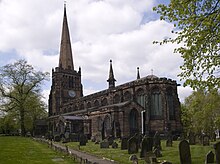Church of SS Peter & Paul, Aston
| SS Peter & Paul, Aston | |
|---|---|
 Building details | |
 | |
| Record height | |
| Tallest in Birmingham from 1838 to 1855[I] | |
| Preceded by | Unknown, most likely a church |
| Surpassed by | St Martin in the Bull Ring |
| General information | |
| Estimated completion | 1480 |
 | |
| 52°30′25″N 1°52′47″W / 52.5070°N 1.8797°W | |
| Denomination | Church of England |
| Churchmanship | Evangelical |
| Website | www.astonnechellscofe.org.uk |
| History | |
| Dedication | St Peter & St Paul |
| Specifications | |
| Height | 58 metres (190 ft) |
| Administration | |
| Province | Canterbury |
| Diocese | Birmingham |
| Parish | Aston |
| Clergy | |
| Vicar(s) | Revd Philip Nott Revd Becky Jones |
The Parish Church of St Peter and St Paul (grid reference SP082899) in Witton Lane, Aston, Birmingham, England, is a parish church in the Church of England.
Background
Aston and Northfield are the only churches within the City of Birmingham mentioned in Domesday Book. Lying next to Aston Hall, it is prominently visible from the A38(M) Aston Expressway.
History
There is a little 14th-century stonework remaining. The steeple dates from the 15th century, partially rebuilt 1776–77 by John Cheshire. Otherwise the church dates from a design (1879–90) by J. A. Chatwin. It contains many old monuments including an alabaster knight of c. 1360 and a sandstone lady of c. 1490.
It is Grade II* listed.[1][2]
Organ
The church had a 3 manual pipe organ built by Banfield in 1901.
List of organists
- Thomas F Thomason c. 1912[3]
Churchyard
The churchyard contains the 30 war graves of service personnel: 26 soldiers, a Marine and airman of World War I, and two airmen of World War II.[4]
References
- ^ Pevsner Architectural Guides - Birmingham, Andy Foster, 2005, ISBN 0-300-10731-5
- ^ Historic England. "Details from listed building database ({{{num}}})". National Heritage List for England. Retrieved 15 June 2006....In the 1950s and 1960s the 37th Boys Brigade from Lichfield Road would have a weekly Parade on Sunday mornings.
- ^ Dictionary of Organs and Organists. First Edition. 1912
- ^ [1] CWGC Cemetery Report. Breakdown obtained from casualty record.
